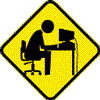I'm here because this awkward situation caused the receiver-stick for my wireless mouse to get caught in my jacket sleeve. I didn't realize the problem until I went to move my arm to the keyboard... The front portion (harddrive, touchpad, fingerprint reader area) of my computer lifted at least six inches off the table then slammed back down before I could realize what was happening. I just barely managed to steady it before it toppled over. The harddrive light went amber, which is supposed to mean a shock was detected and the disk was stopped to save it. The only problem is that it was playing music from my hard drive at the time and that music neither stopped nor stalled.
According to System Information, my hard drive SMART status is "good," but I'm not sure if I can trust that. After all, my system constantly claims the half-dead, two-broken-cells battery I'm using is in good health while it's charging then decides once it hangs up that it's bad. So I'm particularly worried that this accident may have my poor hard drive heading for the land of doom and gloom. I can't afford repairs out of warranty, nor can I afford a new computer; but if absolutely necessary, I could attempt to gather the money for an external drive and find a way to work with it from there. I'd just need to know before-hand if there is a need for an expensive external drive - in other words, if my current drive is now damaged.
After the drop, it took an eternity for System Restore to load - longer than usual. (I was creating a restore point before I installed something, as I like to make sure I can undo an install if the program doesn't work right etc.) While it was creating the new restore point, the music that was playing stalled horribly. A drum beat repeated four times, but when I clicked back to the portion before it messed up and played it again, it didn't have any problems. The status lights seem to be brighter, though I'll admit I may be imagining that (perhaps the lighting conditions aren't the same; I haven't made much point of looking at the lights since the battery indicator decided several months ago to blink all the time due to my bad battery). But it did seem as if my hard drive light was blinking a lot more frequently than normal for about fifteen minutes after the incident. Even when not playing music or loading anything...
So I'm a little worried, even though it now seems to be working as it was before the drop.
How would I go about making sure the ProtectSmart stuff (that was supposed to stop the drive and is responsible for the amber light that came on when it was dropped) actually did its job? Is there any way to make sure my computer isn't damaged - even beyond the hard drive? I don't want to open it up or get into anything technical, though, as that is far beyond my level of knowledge and my comfort level...
If it matters, according to the properties for my hard drive it is: FUJITSU MHZ2160BH G2 ATA Device.

















 Sign In
Sign In Create Account
Create Account

